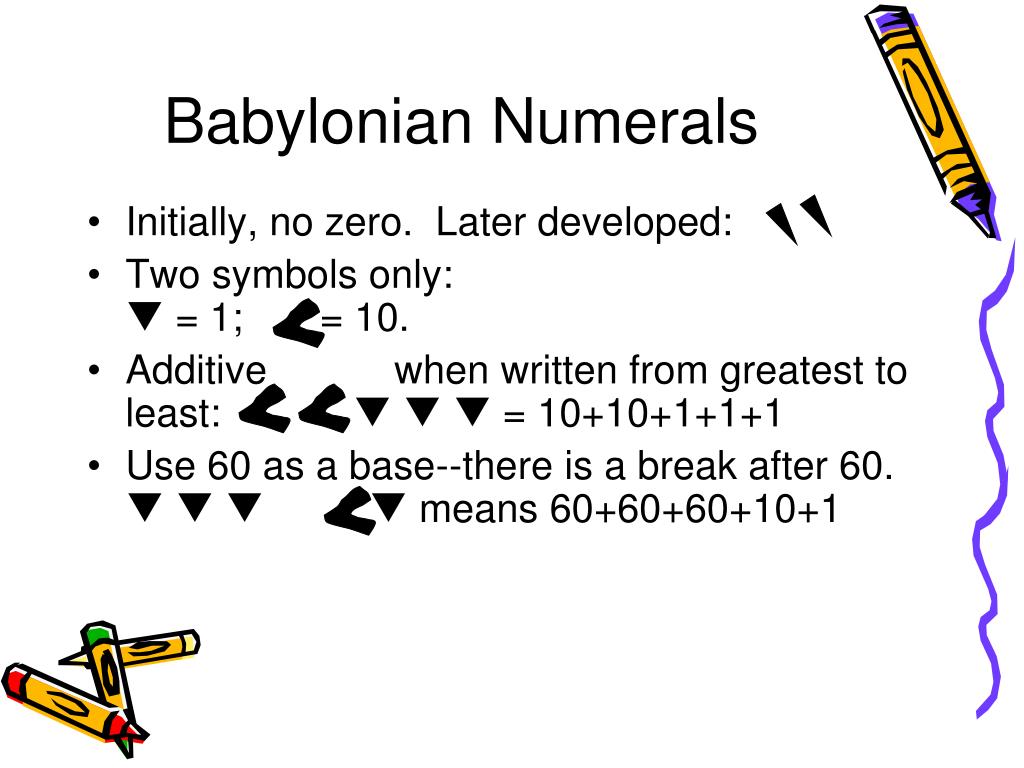

There’s an article on all this in Wikipedia.)īy contrast, in our system 1 can mean 1 or 10 or 100 depending on where it appears in the expression–the 1 in 41 means a different quantity from the 1 in 145, for example.

In fact it appears they didn’t, they used IIII, and IV is more recent.

(You might be thinking: this isn’t quite true–they reversed numbers to indicate subtraction, such as IV for 4. The Roman system is in a way more primitive than ours: X always means 10, C means 100 and I means 1. To appreciate what constitutes a good counting system, it is worthwhile reviewing briefly our own system and that of the Romans. Number Systems: Ours, the Romans and the Babylonians Notice that all these standards of measurement include multiples of 60 frequently–obviously, 60 was the Babylonians’ favorite number. He doesn’t say how many hours in a day, and Neugebauer ( The Exact Sciences in Antiquity, Dover, page 86) claims the Egyptians were the first to come up with twenty-four.) (According to Dampier, A History of Science, Cambridge, page 3, the day was divided into hours, minutes and seconds, and the sundial invented. The basic unit of area was the sar, one square nindan, 400 sq ft, a garden plot.īy 2000 BC, there was a calendar with a year of 360 days, 12 months of 30 days each, with an extra month thrown in every six years or so to keep synchronized with astronomical observations. The league (also called stage and beru) was 180 cords, about seven miles. The cord or rope (used in surveying) was 120 cubits, 200 feet, that is, 3600 fingers. The nindan (or GAR, or rod) was 12 cubits, 20 feet or 6 meters. The cubit (or kush) was 30 fingers, about 20 inches. Next came the finger, or shu-si, equal to 6 she, about 2/3 of an inch. The smallest unit of length was–surprise–the barleycorn, called she, about 1/10 inch. What use was that? At first, the currency was in fact barleycorn! (They later moved to silver and gold ingots.) The shekel was 180 grains (about ¼ ounce), the mina 60 shekels, and the talent 3600 shekels (about 67 pounds). The smallest unit of weight was the grain (about 45 milligrams). This was a practical business decision, which without doubt eliminated much tension in the marketplace. In about 2500 BC, by Royal Edict, weights and measures were standardized in Babylon. Later, it was used for writing down epics, myths, etc., which had earlier probably been handed down by oral tradition, such as the Epic of Gilgamesh. The language continued to be written until the time of Christ, but then it was completely forgotten, even the name Sumer became unknown until the nineteenth century.įrom the earliest times, the language was used for business and administrative documents. Sumer and Babylonia, located in present-day Iraq, were probably the first peoples to have a written language, beginning in Sumer in about 3100 BC. Beams Professor of Physics, Physics Education,Theoretical Condensed Matter Physics


 0 kommentar(er)
0 kommentar(er)
